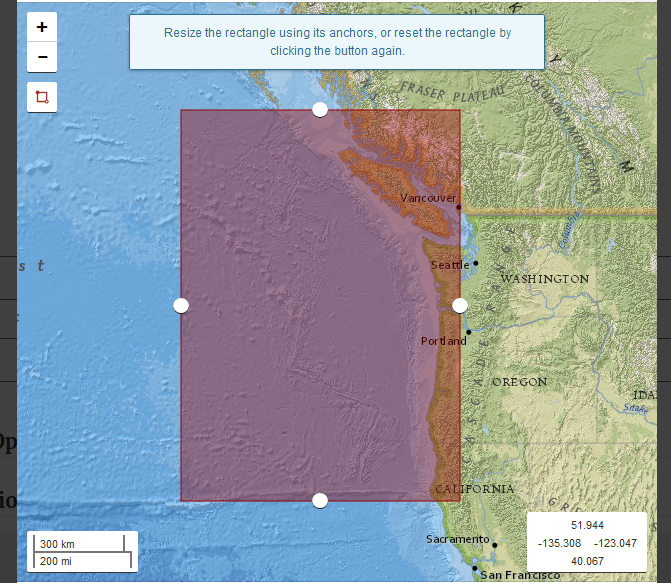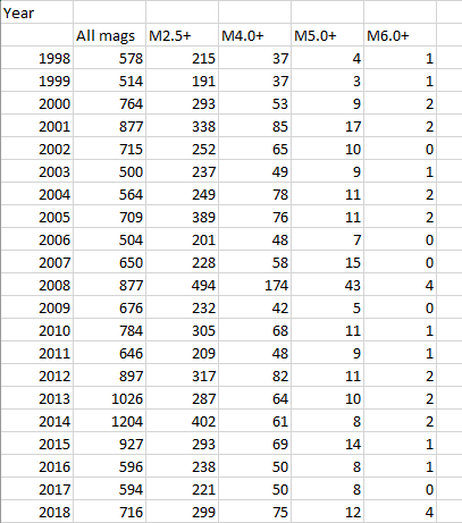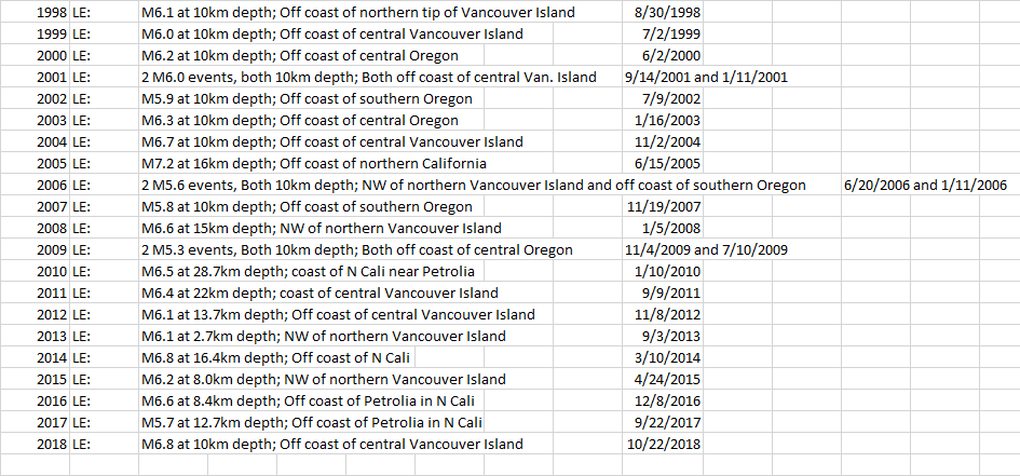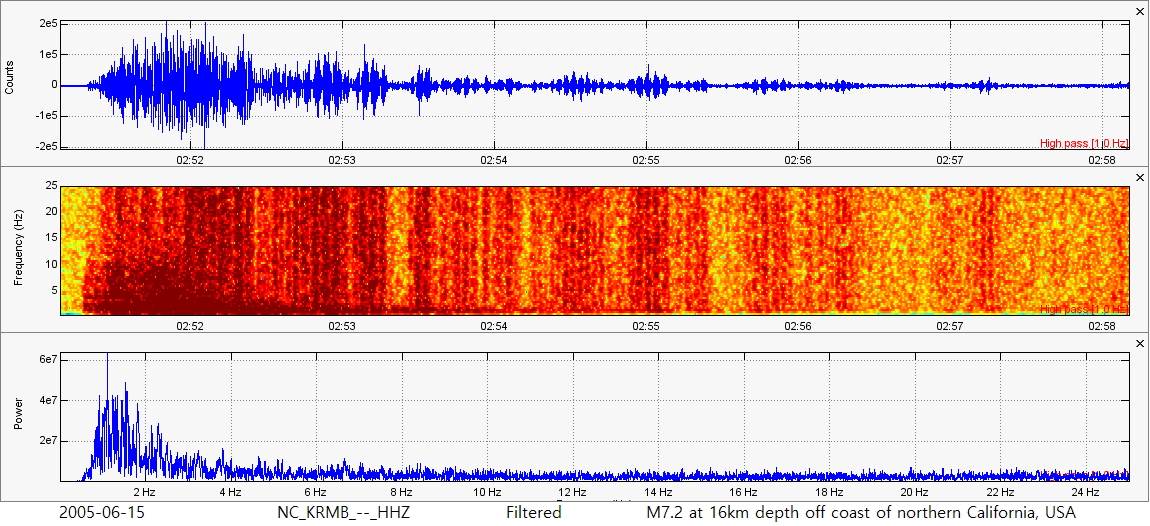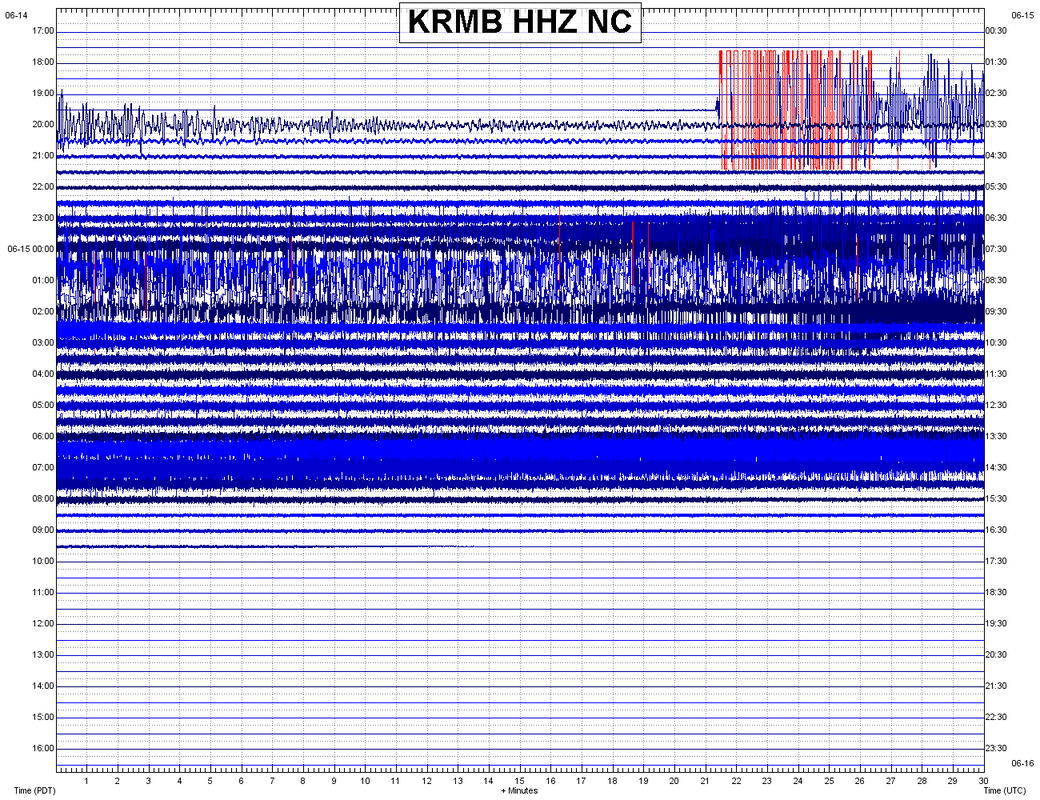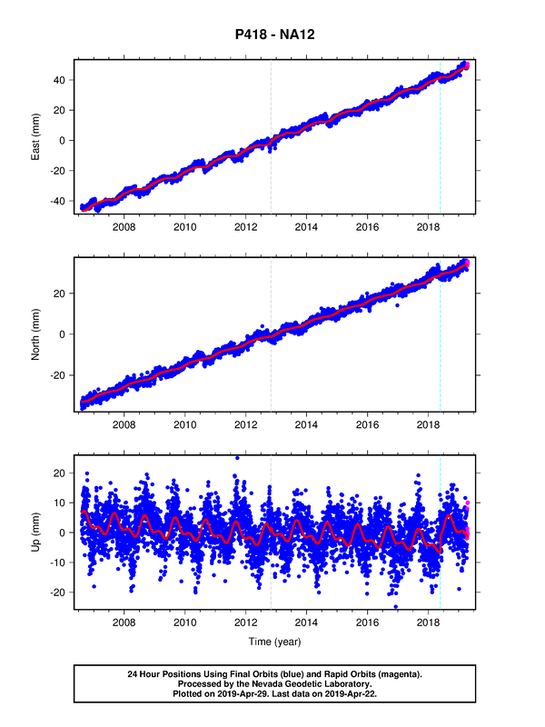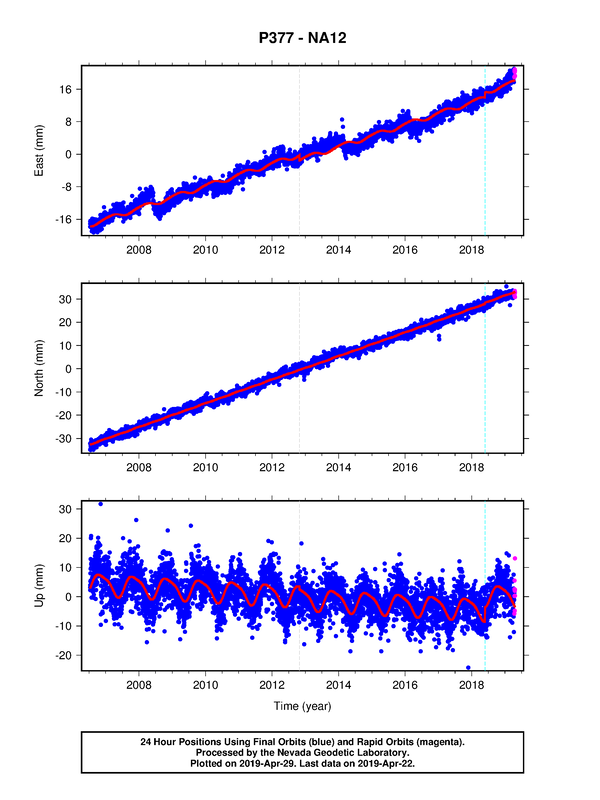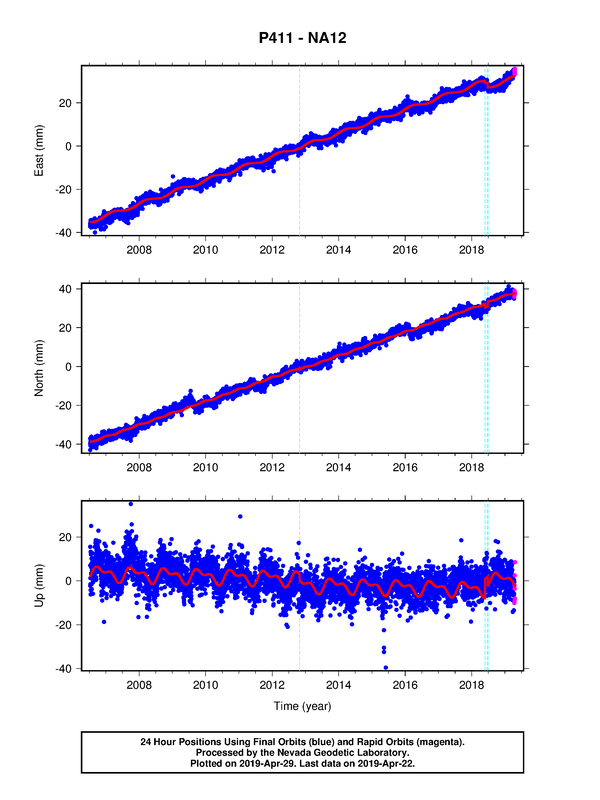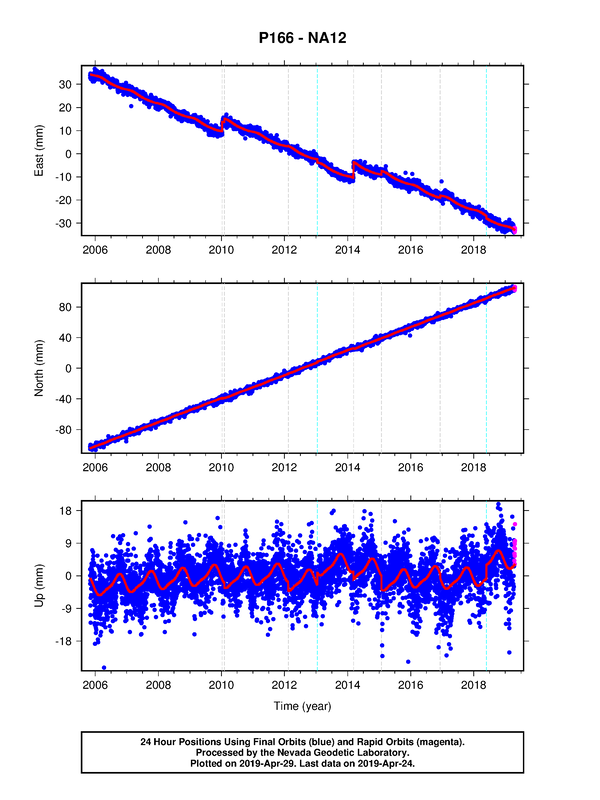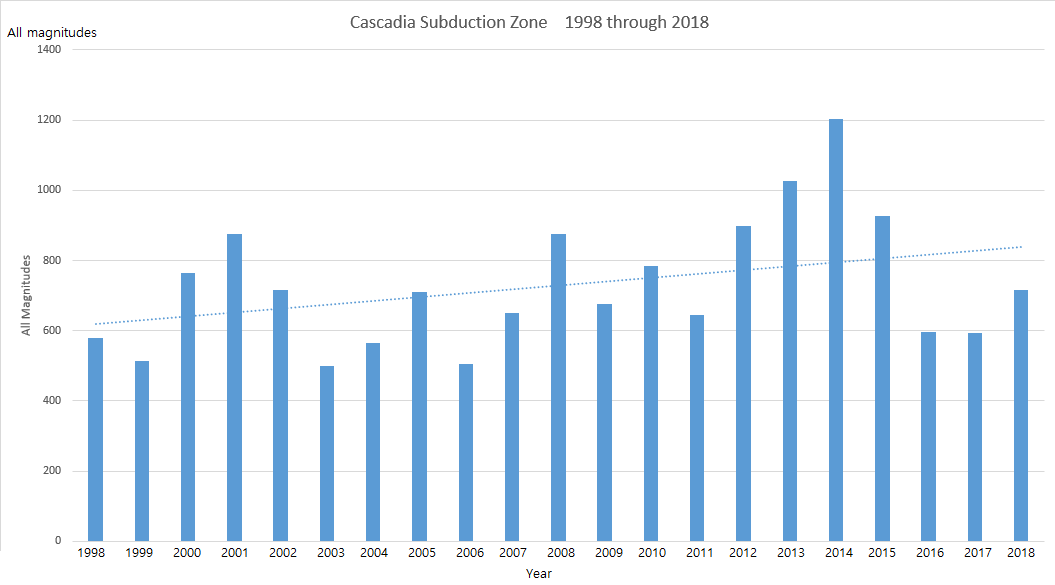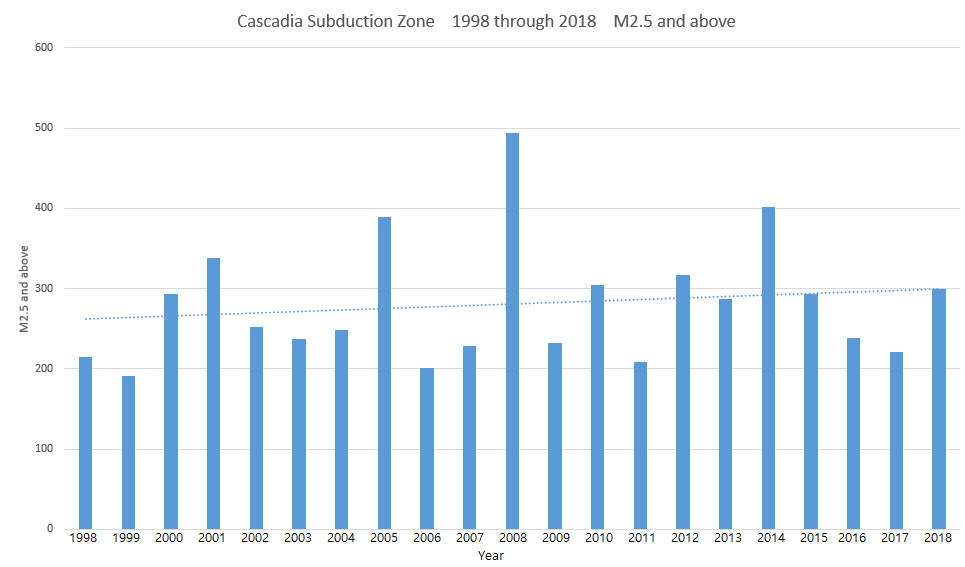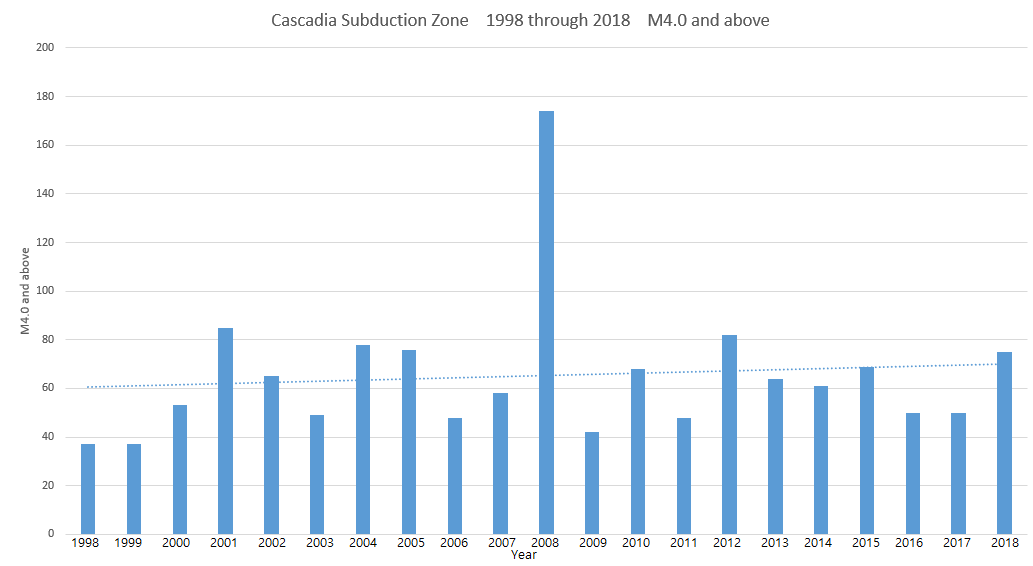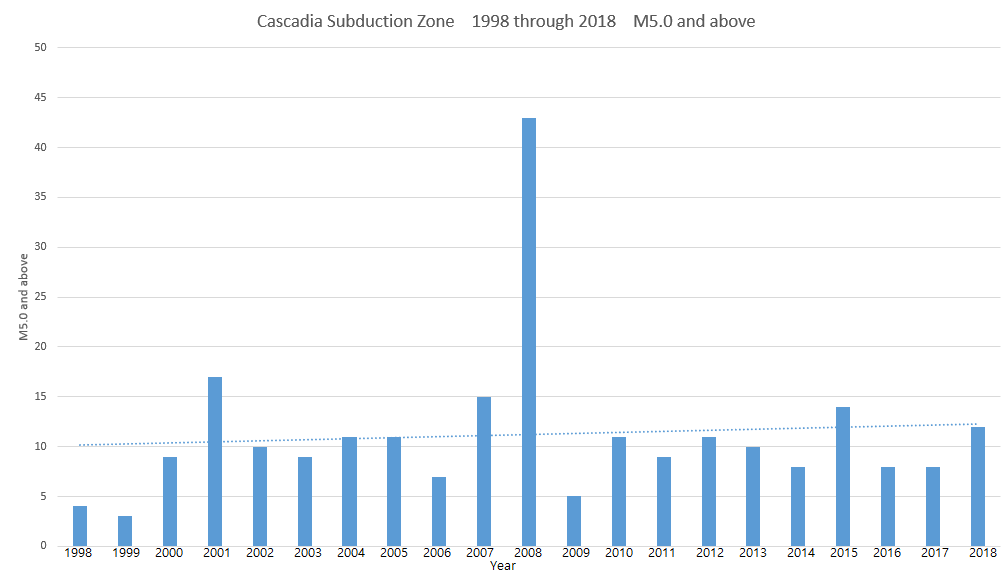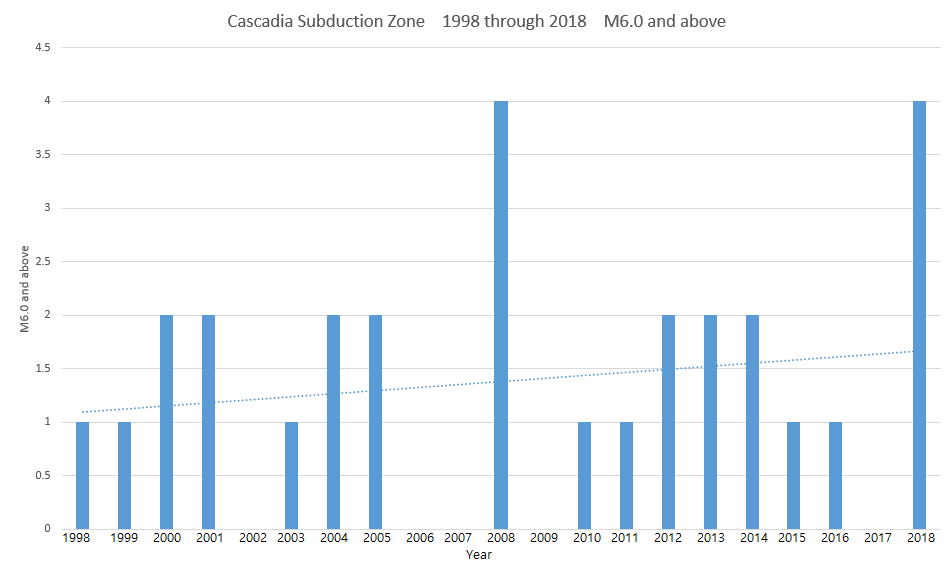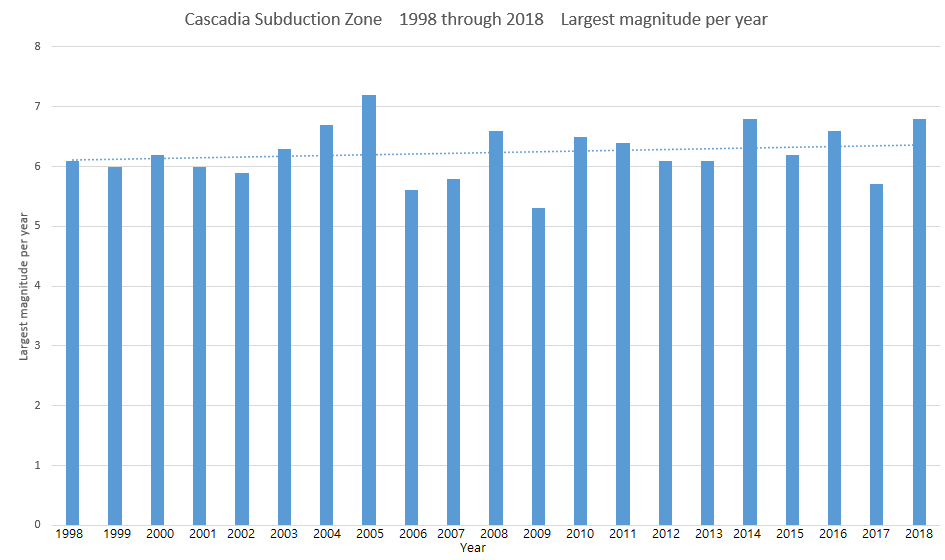The events contained within these statistics are the earthquakes REPORTED, not the ACTUAL number of earthquake events. As of the past few years, record keeping has gained momentum thanks to new technology and equipment updates. However, there are still earthquakes that are not reported by USGS even though the seismic trace of some events in question show on multiple seismic stations *shrug*. However this usually only occurs during earthquake swarms, especially at Yellowstone, and with magnitudes generally below M2.0. Every location in question will have at least 3 magnitudes showing all the earthquakes that occurred within that year at and above the magnitude in question. For example, all magnitudes, M1.5+, M2.5+, and M3.5+. But in regard to the Cascadia Subduction Zone, since it sees larger magnitudes than volcanoes, I will do all magnitudes, M2.5+, M4.0+, M5.0+, and M6.0+. I will also show the coordinate box I used and personal charts I created to give the reader a sense of how earthquake activity supposedly progressed for each magnitude throughout the years. I will also leave some GPS deformation charts if possible. As of right now, it seems earthquake counts for Long Valley caldera and the Cascadia Subduction Zone are more accurate than, for example, Newberry Caldera. Newberry didn’t have accurate seismic monitoring installed until 2011-2012. All earthquake statistics are taken directly from the earthquake catalog at earthquake.usgs.gov. Please let me know if there is anything I should change or if there are any mistakes! Of course these earthquake statistics will be updated once per year. I also encourage others to do the same that I have done!
One more thing. 0.0km in depth means sea level. So if you see an earthquake with a depth of -1.5km but the elevation of the surface is only 1.0km for example, then that means the earthquake occurred in the air. We know that is not possible so if that is true for any of the events, then that means the depth is likely to be very wrong. Another thing to add is the increase of seismic monitoring since 1998. Places like Long Valley caldera and the Cascadia Subduction Zone should not see too noticeable of an increase in reported seismicity that is related to increased monitoring, basically since these areas have been monitored closely for longer than 1998. But places like Yellowstone and Newberry caldera, the low-magnitude seismicity might increase slightly throughout time because of increased monitoring, especially in regards to Newberry. But in regards to Yellowstone, a great many small events are still not reported to this day (it being 2019 right now). This can especially be proven on my West Thumb, Yellowstone page under the Seismic Events dropdown menu above. Many, many small events are not reported even though monitoring is sufficient enough for in depth reporting. I don’t know why this is occurring, so Yellowstone might have a slightly higher seismicity count than the reported count. But most of the time quakes that occur above M1.5 or so are reported regardless.
Earthquake counts are shown first, charts visualizing progression of seismicity are shown second, and my take on the seismic progression is at the bottom. Any additional information will be provided right below. Also, my charts will contain a horizontal trendline (rising, dropping, or level). I know these are important, yes. However trendlines should not be the most important thing to look at. I have seen trendlines head downwards many times when recent activity has started to spike. They are important, but remember to always look at the data first. All dates are in UTC. UTC is ahead of Pacific Time, for example, by 7 hours. This means, for example, an earthquake occurring at 1:00UTC on April 22 would still be April 21 for us here in the USA.
Also, in regards to the largest event section, "LE" means largest event. If dealing with multiples of the same magnitudes, I will post in order from most recent. If you wish to know the locations of any of the GPS stations listed below, either CLICK HERE for the UNR map (where I got some of the deformation plots below) or CLICK HERE for the UNAVCO map. I highly suggest using the UNR map, seeing that you can see all-time plots.
DISCLAIMER: Again, this is the Cascadia Subduction Zone statistics page. Magnitudes are slightly higher on this page since this zone creates larger earthquakes than volcanic areas. Within the coordinate box shown, there may be a few quarry or mine blasts that are reported. I am unable to separate them, simply because of the amount of earthquakes, but they should account for no more than 0.5% of the seismicity counted, maybe even less. That means it really won't make a difference, but I thought it should be mentioned. Also, sometimes when USGS is unsure about the depth of an event, especially in regards to off the West Coast, they automatically set the depth to 10.0km. Of course earthquakes can occur at exactly 10.0km, but sometimes it also means the depth was unable to be constrained correctly.
One more thing. 0.0km in depth means sea level. So if you see an earthquake with a depth of -1.5km but the elevation of the surface is only 1.0km for example, then that means the earthquake occurred in the air. We know that is not possible so if that is true for any of the events, then that means the depth is likely to be very wrong. Another thing to add is the increase of seismic monitoring since 1998. Places like Long Valley caldera and the Cascadia Subduction Zone should not see too noticeable of an increase in reported seismicity that is related to increased monitoring, basically since these areas have been monitored closely for longer than 1998. But places like Yellowstone and Newberry caldera, the low-magnitude seismicity might increase slightly throughout time because of increased monitoring, especially in regards to Newberry. But in regards to Yellowstone, a great many small events are still not reported to this day (it being 2019 right now). This can especially be proven on my West Thumb, Yellowstone page under the Seismic Events dropdown menu above. Many, many small events are not reported even though monitoring is sufficient enough for in depth reporting. I don’t know why this is occurring, so Yellowstone might have a slightly higher seismicity count than the reported count. But most of the time quakes that occur above M1.5 or so are reported regardless.
Earthquake counts are shown first, charts visualizing progression of seismicity are shown second, and my take on the seismic progression is at the bottom. Any additional information will be provided right below. Also, my charts will contain a horizontal trendline (rising, dropping, or level). I know these are important, yes. However trendlines should not be the most important thing to look at. I have seen trendlines head downwards many times when recent activity has started to spike. They are important, but remember to always look at the data first. All dates are in UTC. UTC is ahead of Pacific Time, for example, by 7 hours. This means, for example, an earthquake occurring at 1:00UTC on April 22 would still be April 21 for us here in the USA.
Also, in regards to the largest event section, "LE" means largest event. If dealing with multiples of the same magnitudes, I will post in order from most recent. If you wish to know the locations of any of the GPS stations listed below, either CLICK HERE for the UNR map (where I got some of the deformation plots below) or CLICK HERE for the UNAVCO map. I highly suggest using the UNR map, seeing that you can see all-time plots.
DISCLAIMER: Again, this is the Cascadia Subduction Zone statistics page. Magnitudes are slightly higher on this page since this zone creates larger earthquakes than volcanic areas. Within the coordinate box shown, there may be a few quarry or mine blasts that are reported. I am unable to separate them, simply because of the amount of earthquakes, but they should account for no more than 0.5% of the seismicity counted, maybe even less. That means it really won't make a difference, but I thought it should be mentioned. Also, sometimes when USGS is unsure about the depth of an event, especially in regards to off the West Coast, they automatically set the depth to 10.0km. Of course earthquakes can occur at exactly 10.0km, but sometimes it also means the depth was unable to be constrained correctly.
Cascadia Subduction Zone seismicity counts:
Largest magnitudes per year:
Largest event reported from 1998 through 2018 was a M7.2 at 16km depth; Off coast of northern California on 6/15/2005. Plots shown directly below:
GPS deformation plots created by UNR (link to UNR page above). All stations from which the plots come from reside on the coast of the western United States. One in Washington, two in Oregon, and one in northern California. Locations will be labeled below the plots as a caption:
Charts detailing data from the spreadsheets above:
My opinions/educated guesses:
Clearly you can see seismicity seems to be "breathing" along the Cascadia Subduction Zone. Although seismic monitoring of this area has gained momentum over the past decade or so, many small events were still able to be located from 1998 through 2018. That means any increase you see is unlikely to be due to an increase in monitoring. You can see earthquakes of all magnitudes have been increasing almost steadily since 1998. There was a quick, small dip in 2016 but it seems to be rising. Quantities of larger magnitudes seem to be rising as well, but just barely. Actually, it seems to be breathing in a way with a slight growing trend.
Look at 2008 though! WOW! 2008 was by far the most active year for the Cascadia Subduction Zone than any other year from 1998 through 2018, although 2014 saw the highest count if you include all magnitudes. Note that 2008 was also a year of increased volcanic activity worldwide, including Yellowstone Caldera. Yellowstone saw an extremely concerning earthquake swarm that did indeed point to an intrusion of molten rock (magma). Thank God that intrusion only lasted a week! But still, 2008 was definitely a notable year for seismicity and volcanic activity worldwide.
Look at 2008 though! WOW! 2008 was by far the most active year for the Cascadia Subduction Zone than any other year from 1998 through 2018, although 2014 saw the highest count if you include all magnitudes. Note that 2008 was also a year of increased volcanic activity worldwide, including Yellowstone Caldera. Yellowstone saw an extremely concerning earthquake swarm that did indeed point to an intrusion of molten rock (magma). Thank God that intrusion only lasted a week! But still, 2008 was definitely a notable year for seismicity and volcanic activity worldwide.
